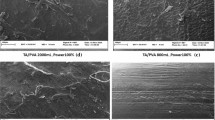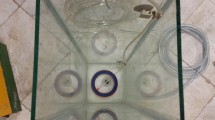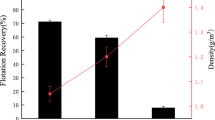Abstract
The separation of an individual plastic from a plastics mix is crucial in plastic recycling management. The selected plastics available in municipal and industrial wastes, including polycarbonate (PC), poly oxy methylene (POM), and acrylonitrile butadiene styrene (ABS) pre-irradiated with microwaves for different microwave power %’s at several irradiation times. The irradiated plastics subsequently conditioned with selected depressants with different concentrations before introducing into the flotation tank. The effects of the above-mentioned parameters evaluated on the float-sink behavior of the studied plastics. It revealed that the pre-microwave irradiation of the plastic surface was influential on the float-sink performance of the studied plastics. The microwave irradiation changed the numbers, capacity, and concentration of the active sites on the plastic surface. The microwave irradiation reduced θ (contact angle) values of the un-conditioned plastic surface with studied depressants for all used plastics resulted in increasing the hydrophilic property of the surface of the plastics. It concluded that different mechanisms, individually or together, involved for depressant adsorption–desorption on a plastic surface. The microwave pre-irradiation for some plastics and depressants was beneficial for plastic flotation whenever for other samples, it helped the plastic to sink at the bottom of the flotation tank. The suggested equations by Design-Expert® software to predict the plastic flotation % versus studied parameters conformed with experimental results appropriately.
Graphic abstract











Similar content being viewed by others
References
Chong-quine Wang H (2015) Wang. J Gang Fu, You-nian Liu, Flotation separation of waste plastics for recycling-A review, Waste Manag 41:28–38
Gu F, Guo J, Zhang W, Summers PA, Hall P (2017) From waste plastics to industrial raw materials: A life cycle assessment of mechanical plastic recycling practice based on a real-world case study. Sci Total Environ 601–602:1192–1207
Davari MR, Ostad Movahed S (2019) The Flotation by Selected Depressants as an Efficient Technique for Separation of a Mixed Acrylonitrile Butadiene Styrene, Polycarbonate and Polyoxymethyleneplastics in waste streams. J. Polym. Environ. 27:1709–1720
Negari MS, Ostad Movahed S, Ahmadpour A (2018) Separation of polyvinylchloride (PVC), polystyrene (PS) and polyethylene terephthalate (PET) granules using various chemical agents by flotation technique. Sep. Purif. Technol. 194:368–376
Gent R, Malcolm Menendez M, Toraño J, Torno S (2011) Optimization of the recovery of plastics for recycling by density media separation cyclones. Resour. Conserv. Recycl 55:472–482
Lee JJS, Mo JPT, Wu DY (2012) Polymer recovery from auto shredder residue by projectile separation method. Sustainability-Basel 4:643–655
Gent M (2009) Recycling of plastic waste by density separation: Prospects for optimization. Waste Manage Res 27:175–187
Pappa G et al (2001) The selective dissolution/precipitation technique for polymer recycling: a pilot unit application. Resour Conserv Recycl 34:33–44
Weeden GS, Soepriatna NH, Wang NL (2015) Method for efficient recovery of high-purity polycarbonates from electronic waste. Environ Sci Technol 49:2425–2433
Zhao Y, Lv X, Yang W, Ni H (2017) Laboratory simulations of the mixed solvent extraction recovery of dominate polymers in electronic waste. Waste Manage 69:393–399
Wu G, Li J, Xu Z (2013) Triboelectrostatic separation for granular plastic waste recycling: A review. Waste Manage 33:585–597
Silveira AVM, Cella M, Tanabe EH, Bertuol DA (2018) Application of triboelectrostatic separation in the recycling of plastic wastes. Process Saf Environ 114:219–228
Li J, Wu G, Xu Z (2015) Tribo-charging properties of waste plastic granules in process of tribo-electrostatic separation. Waste Manage 35:36–41
Gu GH, Hu YH, Qiu GZ, Wang H, Wang DZ (2002) Potential control flotation of galena in strong alkaline media. J Cent South Univ Technol 9:16–20
G. Deiringer, G. Edelmann, B. Rauxloh, U.S.Patent,5248041(1993).
Burat F, Güney A, OlgaçKangal M (2009) Selective separation of virgin and postconsumer polymers (PET and PVC) by flotation method. Waste Manage 29:1807–1813
Takoungsakdakun T, Pongstabodee S (2007) Separation of mixed post-consumer PET–POM–PVC plastic waste using selective flotation. Sep Purif Technol 54:248–252
Kangal MO (2010) Selective flotation technique for separation of PET and HDPE used in drinking water bottles. Min Proc Ext Met Rev 31:214–223
Basařová P, Bartovská L, Kořínek K, Horn D (2005) The influence of flotation agent concentration on the wettability and flotability of polystyrene. J Colloid Interf Sci 286:333–338
Guo J, Li X, Guo Y, Ruan J, Qiao Q, Zhang J, Bi Y, Li F (2016) Research on flotation technique of separating pet from plastic packaging wastes. Procedia Environmental Sciences 31:178–184
Yenial U, Burat F (2013) Separation of PET and PVC by Flotation Technique Without Using Alkaline Treatment. Min. Proc. Ext. Met. Rev. 34(6):412–421
Güney A, Özdilek C, Kangal MO, Burat F (2015) Flotation characterization of PET and PVC in the presence of different plasticizers. Sep Purif Technol 151:47–56
Yuce AE, Kilic M (2015) separation of PVC/PET mixture from plastic wastes using column flotation technique. J Environ Prot Ecol 16:705–715
Pascoe RD (2005) The use of selective depressants for the separation of ABS and 65 HIPS by froth flotation. Miner Eng 18:233–237
Motasemi F, Afzal MT (2013) A review on the microwave-assisted pyrolysis technique. Renew Sustain Energy Rev 28:317–330
Mollanorouzi M (2016) Saeed Ostad Movahed, Reclaiming waste tire rubber by an irradiation technique. Polym Degrad Stab 128:115–125
Movahed SO, Ansarifar A, Zohouri GH, Ghanei R, Kermani Y (2016) Devulcanization of ethylene–propylene–diene waste rubber by microwaves and chemical agents. J. Elastom. Plast. 48:122–144
Khavarnia M (2016) Saeed Ostad Movahed, Butyl rubber reclamation by combined microwave radiation and chemical reagents. J Appl Polym Sci 133:43363–43373
Srinivasa Reddy Mallampati (2018) Chi-Hyeon Lee, Min Hee Park, Byeong-Kyu Lee, Processinplastics from ASR/ESR waste: separation of poly vinyl chloride (PVC) by froth flotation aftemicrowave-assisted surface modification. J Mater Cycles Waste Manag 20:91–99
Gan Cheng; Ziyou Li (2020) Yijun Cao, Zhendong Jiang, Research progress in lignite flotation intensification. International Journal of Coal Preparation and Utilization 40:59–76
Truc NTT, Lee B-K (2017) Combining ZnO/microwave treatment for changing wettability of WEEE styrene plastics (ABS and HIPS) and their selective separation by froth flotation. Appl Surf Sci 420:746–752
Srinivasa Reddy Mallampati (2018) Chi-Hyeon Lee, Min Hee Park, Byeong-Kyu Lee, Processing plastics from ASR/ESR waste: separation of poly vinyl chloride (PVC) by froth flotation after microwave-assisted surface modification. J Mater Cycles Waste Manag 20:91–99
Irannajad M, Mehdilo A (2014) Omid Salmani Nuri, Influence of microwave irradiation on ilmenite flotation behavior in the presence of different gangue minerals. Sep Purif Technol 132:401–412
Huang L, Wang H, Wang C, Zhao J, Zhang Bo (2017) Microwave-assisted surface modification for the separation of polycarbonate from poly methyl methacrylate and polyvinyl chloride waste plastics by flotation. Waste Manag Res 35:294–300
Zhang Y, Jiang H, Wang H, Wang C, Yichen Du, Wang L (2020) Flotation separation of polystyrene and polyvinyl chloride based on heterogeneous catalytic Fenton and green synthesis of nanoscale zero valent iron (GnZVI). J Clean Prod 267:122116
Zhang Y, Jiang H, HuiWang ChongqingWang (2020) Flotation separation of acrylonitrile-butadiene-styrene and polystyrene in WEEE based on oxidation of active sites. Miner. Eng. 146:106131
Zhang Y, Jiang H, Wang H (2020) Separation of hazardous polyvinyl chloride from waste plastics by flotation assisted with surface modification of ammonium persulfate: Process and mechanism. J. Hazard. Mater. 389:121918
Zhang Y, Jiang H, Wang K, Wang H, ChongqingWang, (2020) Green flotation of polyethylene terephthalate and polyvinyl chloride assisted by surface modification of selective CaCO3 coating, ). J. Clean. Prod. 242:118441
HuiWang YingshuangZhang (2019) Chonqing Wang, Surface modification and selective flotation of waste plastics for effective recycling- a review. Sep Purif Technol 226:75–94
Shen H, Forssberg E, Pugh RJ (2002) Selective flotation separation of plastics by chemical conditioning with methyl cellulose. Resour Conserv Recycl 35:229–241
Aumann T, Theirich D, Engemann J (2001) Rapid surface modification of polyethylene in microwave and rf-plasmas: comparative study. Surf. Coat. Technol. 142–144:169–174
Zhao Q (2014) ShengZhang, Mingzhe Dong, Peng Jiang, Zhongwu Hu, Surface modification of polyamide 66 fabric by microwave induced grafting with 2-hydroxyethyl methacrylate. Surf Coat Technol 240:197–203
Saleh NS, Ostad Movahed S (2018) Attarbashi, Study on the anti-biofouling effects of the grafted polyamide 6 fibers by several vinyl chemicals. J. Appl. Polym. Sci. 135:46760–46770
Ginn BT, Steinbock O (2003) Polymer Surface Modification Using Microwave-Oven-Generated Plasma. Langmuir 19:8117–8118
Masel IR (1996) Principles of adsorption and reaction on solid surfaces. Wiley, New York
Gregg GC, Sing KSW (1982) Adsorption, surface area and porosity, 2nd edn. Academic, London
Zhao Y, Yang S, Wen H, Shen Z, Han F (2019) Adsorption behavior and selectivity mechanism of flotation reagents applied in ternary plastic mixtures. Waste Manage 87:565–576
Acknowledgements
The authors sincerely thank the staff of the polymer chemistry laboratory located at the faculty of science, the Ferdowsi University of Mashhad, for their sincere cooperation. Approval no. 3/51149.
Author information
Authors and Affiliations
Corresponding author
Ethics declarations
Conflict of interest
The authors declare that they have not any financial/commercial conflicts of interest.
Additional information
Publisher's Note
Springer Nature remains neutral with regard to jurisdictional claims in published maps and institutional affiliations.
Supplementary Information
Below is the link to the electronic supplementary material.
Rights and permissions
About this article
Cite this article
Heidarpour, M., Movahed, S.O. & Jourabchi, S. The Effect of Microwave Irradiation on the Flotation of the Selected Polymers as a Potential Solution for Plastic Recycling. J Polym Environ 29, 3130–3144 (2021). https://doi.org/10.1007/s10924-021-02105-6
Accepted:
Published:
Issue Date:
DOI: https://doi.org/10.1007/s10924-021-02105-6




